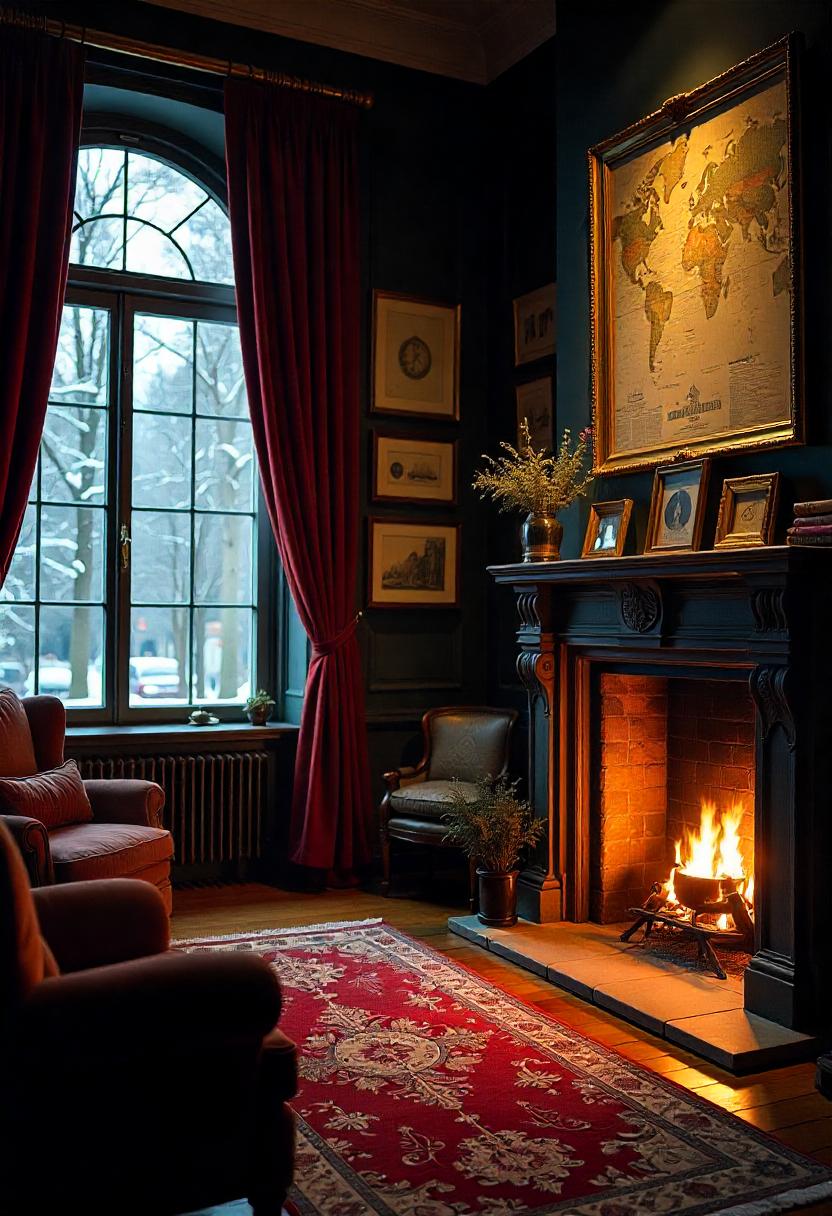I never understood why my living room felt so… soulless.
Despite my best efforts with trendy décor from big box stores, something was missing.
Then one rainy afternoon, while lost in a Victorian novel, it hit me – my space needed the moody, intellectual aesthetic that matched my inner world.
My journey into dark academia began with a vintage leather chair I rescued from an estate sale.
That single piece transformed my living room into a space that whispered of midnight philosophy discussions and the comforting scent of old books.
Now, entering my living room feels like stepping into a forgotten university library where great minds once gathered.
✨Click to Get My 101 FREE Designer Room Ideas
1. Vintage Leather and Wood: The Foundation of Dark Academia

Nothing says dark academia like rich, weathered leather furniture paired with dark wood accents.
Look for a statement leather chair or sofa in deep brown, oxblood, or black that shows character through natural wear.
The more lived-in it appears, the more authentic your space will feel.
Complement your seating with wooden elements – a solid oak bookcase, a mahogany coffee table, or a walnut desk with intricate detailing.
The goal is to create a space that feels like it has witnessed countless late-night discussions about philosophy and literature.

Thrift stores, estate sales, and antique shops are your best friends for finding these pieces with history embedded in their imperfections.
Don’t be afraid of scratches, patina, or slight damage – these tell a story and add to the academic mystique.
If your budget is tight, consider refinishing thrifted wooden furniture in dark stains to achieve that library-worthy look.
Add brass or bronze hardware to wooden pieces for an extra touch of vintage sophistication.
Mismatched pieces often work beautifully together in dark academia spaces – uniformity is not the goal.
Position your leather seating near natural light to highlight its rich texture and create a perfect reading nook.
A wooden trunk repurposed as a coffee table can double as storage for blankets and literary magazines.
2. Books, Books, and More Books: Creating Your Personal Library

The heart of any dark academia space is an impressive collection of books – preferably leather-bound, cloth-covered, or beautifully aged paperbacks.
Arrange your books both horizontally and vertically to create visual interest on your shelves.
Don’t hide your most beautiful editions – display them with their covers facing outward as art pieces in their own right.
Look for vintage encyclopedias, classical literature collections, and art history tomes at second-hand bookshops and library sales.
The subject matter matters less than the physical presence of books that appear to have been collected over a lifetime of intellectual curiosity.
Stack books on coffee tables, side tables, and even on the floor beside seating areas to create that lived-in scholarly atmosphere.
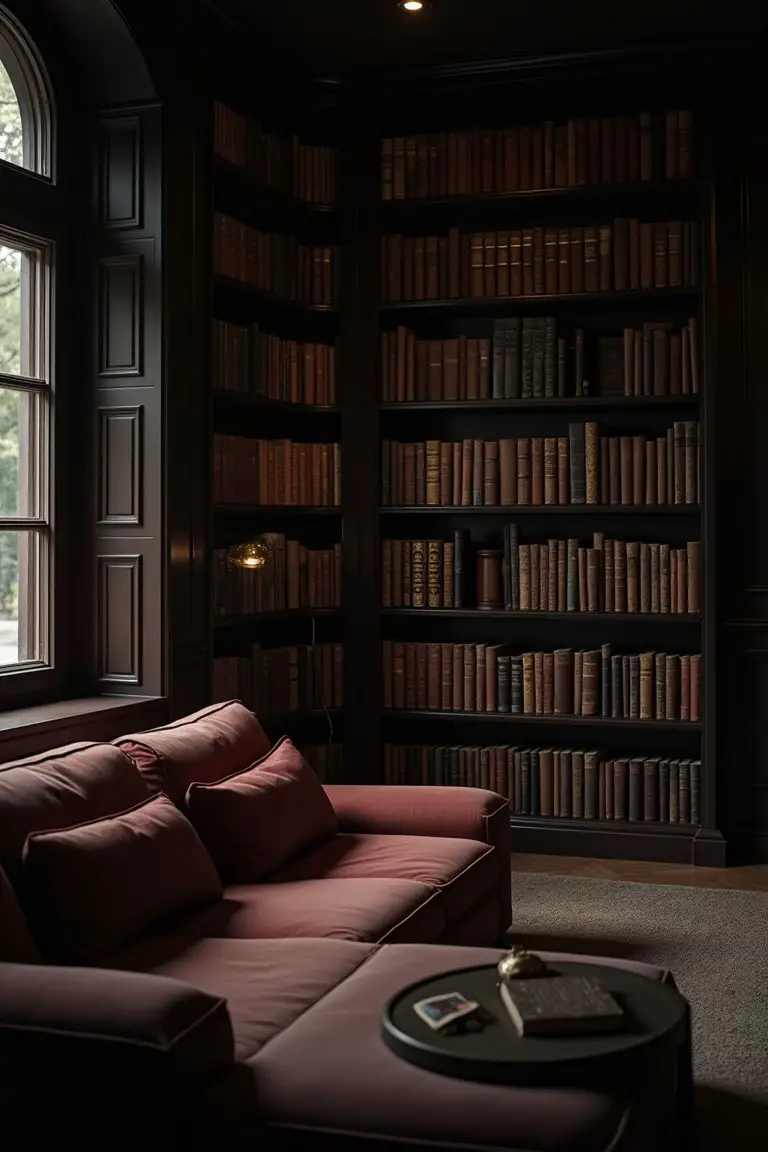
Consider organizing sections by color for a subtle rainbow effect, or go completely chaotic for that “passionate collector” vibe.
Integrate bookends made of bronze, marble, or carved wood to add artistic elements to your shelves.
Leave space between book clusters for small antiquities, preserved specimens, or framed portraits to break up the monotony.
Install floating shelves in unexpected places – above doorways, flanking windows – to maximize your book display potential.
Remember that your book collection should appear curated rather than simply accumulated – each volume suggesting a curious mind behind its selection.
For the true dark academia effect, include some books in foreign languages, particularly Latin, Greek, French, or German texts.
3. Atmospheric Lighting: Creating Scholarly Ambiance
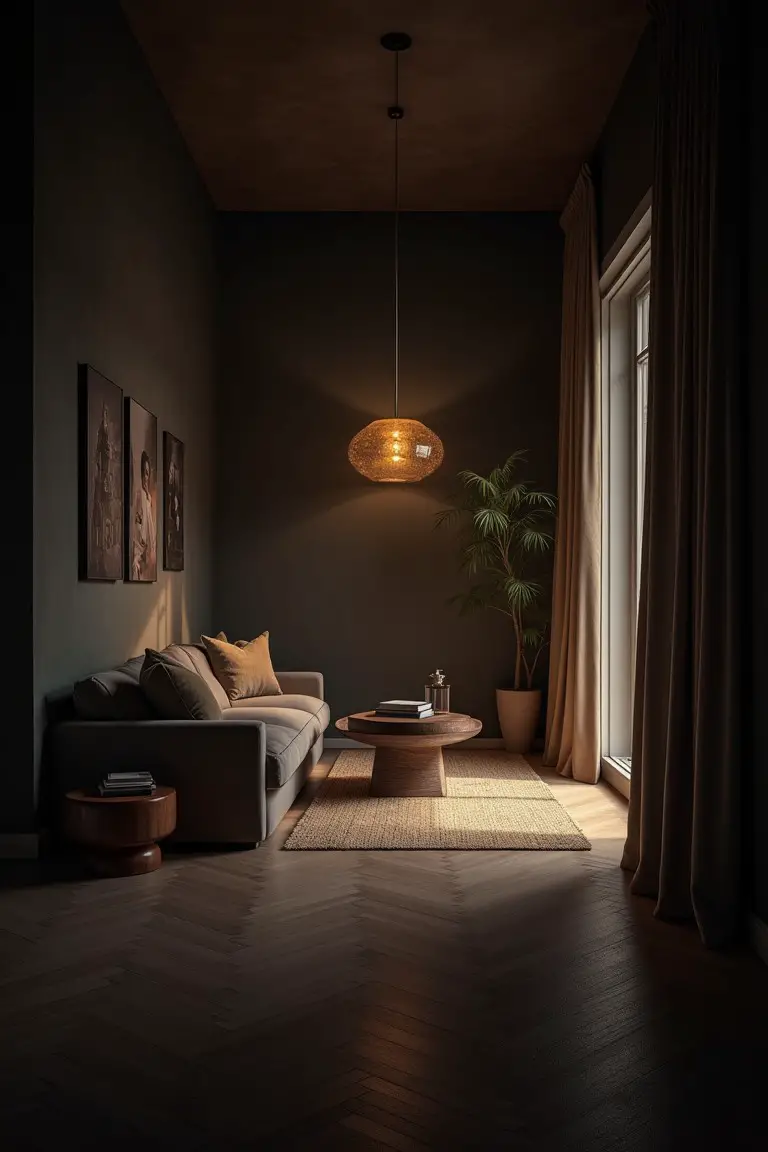
Banish harsh overhead lighting in favor of warm, layered light sources that create pools of illumination throughout your space.
Invest in brass or bronze desk lamps with green glass shades – the iconic “banker’s lamp” is perfect for this aesthetic.
Place floor lamps with fabric shades near reading chairs to create cozy spots for late-night literary exploration.
Consider wall sconces with fluted glass shades or candle-style fixtures to evoke a collegiate hall atmosphere.
Fairy lights artfully strung across bookshelves or around window frames add a magical quality to evening ambiance.
True dark academia devotees embrace candlelight – collect brass, silver, or wooden candlesticks of varying heights for dramatic table displays.

Look for vintage light fixtures at architectural salvage stores to add authentic period character to your space.
Choose warm-toned bulbs (2700K or lower) that cast a golden glow rather than clinical white light.
Create dramatic shadows by positioning lights to illuminate certain features while leaving others in mysterious darkness.
The goal is to create a space that looks equally inviting by day and mysteriously cozy by night.
Consider installing dimmer switches to adjust the mood from study session to philosophical discussion as the evening progresses.
Don’t underestimate the power of natural light filtered through heavy curtains – that diffused glow is perfect for this aesthetic.
4. Rich, Moody Color Palette: Embracing Scholarly Darkness

Paint your walls in deep, saturated hues – think oxford blue, forest green, burgundy, or charcoal gray.
If painting all walls feels too committed, create a dramatic accent wall behind bookshelves or in a reading nook.
Don’t shy away from dark wood trim, crown molding, or wainscoting – these architectural details enhance the traditional academic feel.
Balance darker walls with cream or ivory ceilings to prevent the space from feeling too cave-like.
Consider wallpaper with subtle patterns – damask, toile, or vintage botanical prints work beautifully in dark academia spaces.

Extend your color palette to your furniture with richly upholstered pieces in complementary dark tones.
Add warmth through textiles – burgundy throw pillows, navy blankets, or emerald green curtains add depth to your color story.
Remember that dark academia isn’t monochromatic – incorporate rich jewel tones alongside your deeper base colors.
Metallic accents in brass, bronze, or aged gold prevent dark colors from feeling too heavy or somber.
Choose artwork with complementary color schemes to maintain the cohesive aesthetic.
For a truly authentic look, consider antiquing techniques on walls or furniture – patina and age are highly prized in this aesthetic.
Don’t forget that dark doesn’t mean gloomy – your space should feel rich and layered rather than depressing.
✨Click to Get My 101 FREE Designer Room Ideas
5. Vintage Maps and Scientific Charts: Scholarly Wall Décor

Hunt for old astronomical charts, anatomical diagrams, or botanical illustrations to adorn your walls with intellectual curiosity.
Frame vintage maps – world maps, city plans from historic periods, or nautical charts add both color and academic flair.
Look for reproductions of classical art, Renaissance portraits, or Dutch still life paintings to cultivate an atmosphere of artistic appreciation.
Create a gallery wall mixing scientific illustrations with black and white photographs and small oil paintings for maximum impact.
Consider framing pages from antique books – particularly those with beautiful illustrations or interesting typographic layouts.
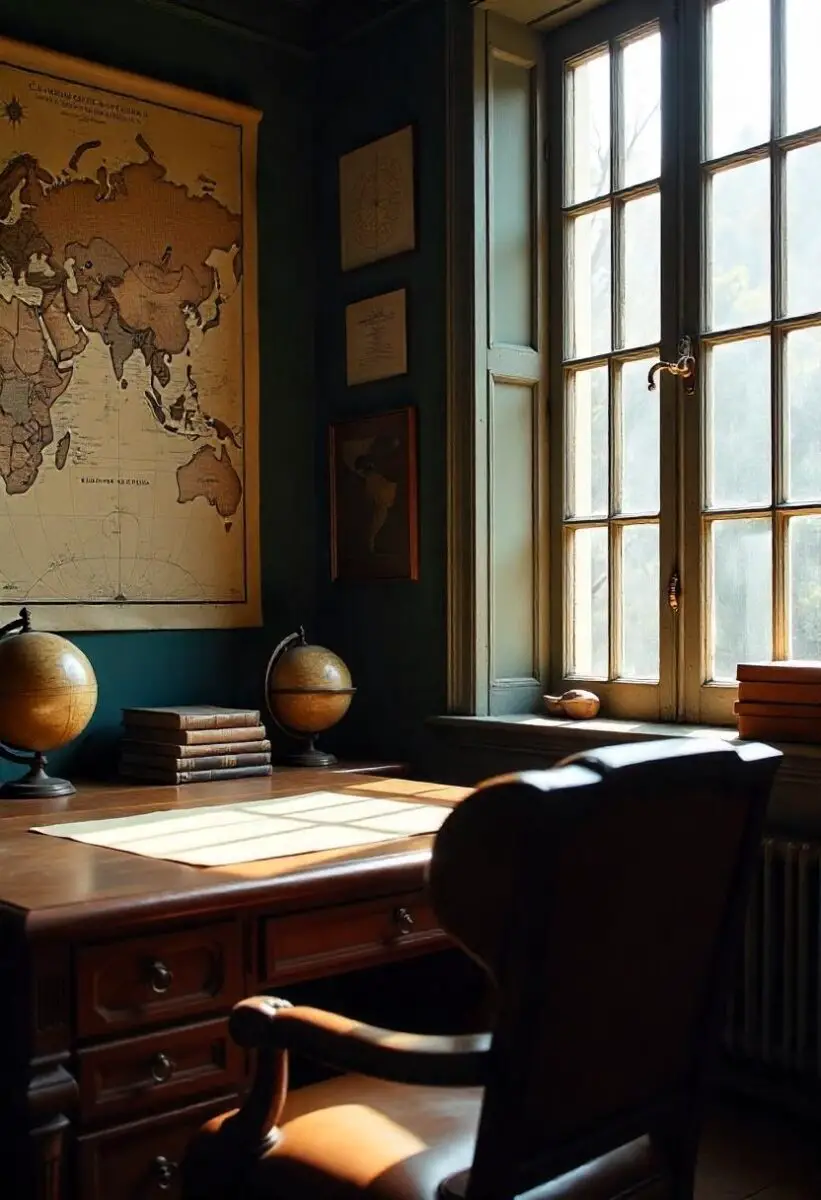
Architectural drawings, especially of classical buildings, bridges, or cathedrals, perfectly capture the dark academia appreciation for design.
Display these pieces in mismatched vintage frames – gold, dark wood, and ornate styles work beautifully together.
Hang your art salon-style, covering walls from floor to ceiling for a collector’s approach to décor.
Consider large-scale pieces like pull-down school charts or framed tapestries as dramatic focal points.
Look beyond traditional art sources – flea markets, estate sales, and online archives offer unique finds that won’t break your budget.
Don’t be afraid to mix reproduction prints with authentic vintage pieces – it’s the overall effect that matters.
Each piece should feel like it has been chosen for its intellectual or aesthetic significance, not just to fill wall space.
6. Curiosity Cabinets: Displaying Scholarly Collections

Channel the Renaissance tradition of “cabinets of curiosities” by displaying collections of natural specimens and intellectual ephemera.
Look for glass-fronted cabinets, vintage display cases, or open shelving to showcase your carefully curated treasures.
Collect items that suggest scientific inquiry – mineral specimens, preserved insects, shells, or small fossils arranged with museum-like precision.
Incorporate small antique scientific instruments – brass compasses, magnifying glasses, or miniature telescopes add authentic scholarly flair.
Group similar objects together for visual impact – a collection of vintage hourglasses, antique keys, or small marble busts.
Add elements from the natural world – dried flowers, seed pods, bird’s nests, or interesting pieces of driftwood.

Illuminate your collections with small picture lights or battery-operated LEDs to draw attention to these thoughtful arrangements.
Label items with handwritten cards or typed descriptions on aged paper for that museum-quality presentation.
Presentation matters – line drawers with velvet, use small specimen boxes, or display delicate items under glass domes.
These displays should evolve over time as you discover new treasures that speak to your intellectual interests.
Create seasonal rotations of your collections to maintain visual interest and reflect changing academic pursuits.
The goal is to create vignettes that invite closer inspection and spark conversations about the wonders of the natural and intellectual world.
7. Writing Stations: Creating Scholarly Workspaces
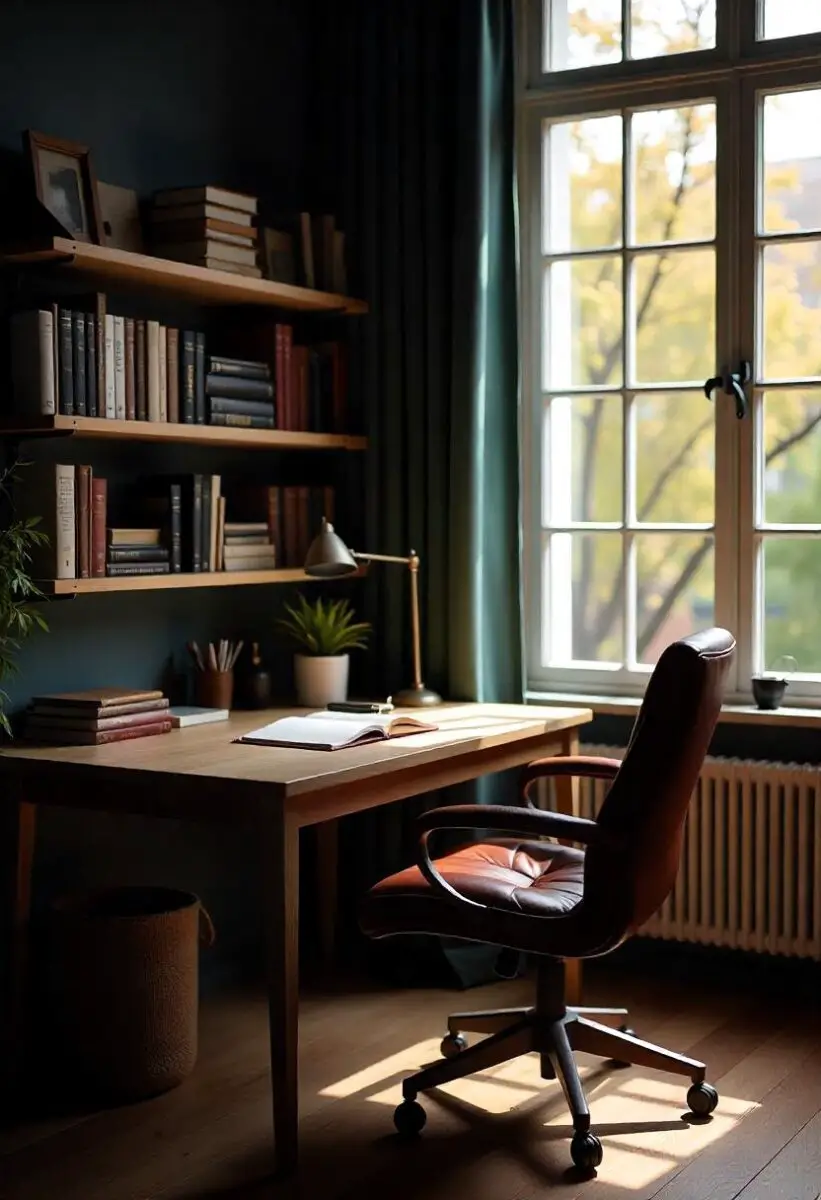
Every dark academia living room needs a dedicated space for writing, studying, and intellectual pursuit.
Seek out a substantial wooden desk – a roll-top, partners desk, or library table with history embedded in its scratches and ink stains.
Position your desk near a window to capture natural light but arrange it to provide a view of your carefully curated space.
Outfit your writing station with analog tools – fountain pens, leather-bound journals, blotting paper, and a proper inkwell.
Add brass desk accessories – letter openers, paper weights, letter trays, and stamp boxes add functional beauty.
Include a comfortable desk chair that encourages proper posture during long hours of study and contemplation.

Organize your writing supplies in wooden boxes, leather containers, or vintage desk organizers rather than plastic or contemporary options.
Create a stack of reference materials within arm’s reach – dictionaries, thesauri, and subject-specific references suggest serious scholarship.
Add a desk lamp with adjustable positioning to provide proper light for late-night writing sessions.
Consider a small typewriter as both functional tool and decorative element – the sound of keys striking paper is quintessentially academic.
Keep digital necessities like laptops or tablets in leather cases or wooden docking stations when not in use to maintain the aesthetic.
Remember that your writing station should feel like a place where great thoughts are developed and important words committed to paper.
8. Textural Textiles: Layering Comfort and Sophistication
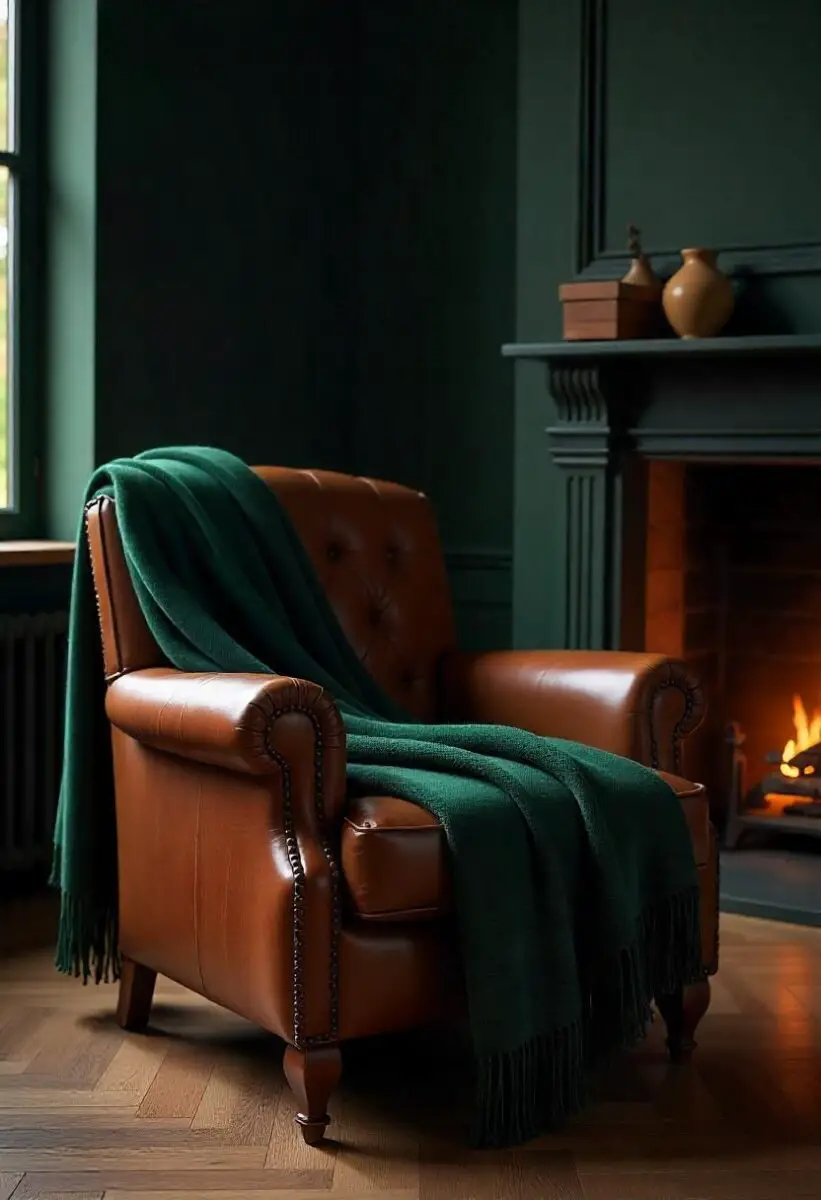
Incorporate rich textural elements through carefully selected textiles that add warmth and depth to your academic haven.
Look for wool throws in plaids, herringbone patterns, or solid jewel tones to drape across leather chairs and sofas.
Add velvet pillows in deep burgundy, forest green, or navy blue for both comfort and visual luxury.
Consider heavyweight curtains in damask, brocade, or velvet that pool slightly on the floor for dramatic effect.
Invest in a vintage Persian or Turkish rug with rich colors and complex patterns to anchor your furniture groupings.
Layer smaller rugs over larger ones to define reading areas and add additional texture to your floors.
Add a leather or velvet ottoman that can serve as both footrest and supplementary seating during scholarly gatherings.
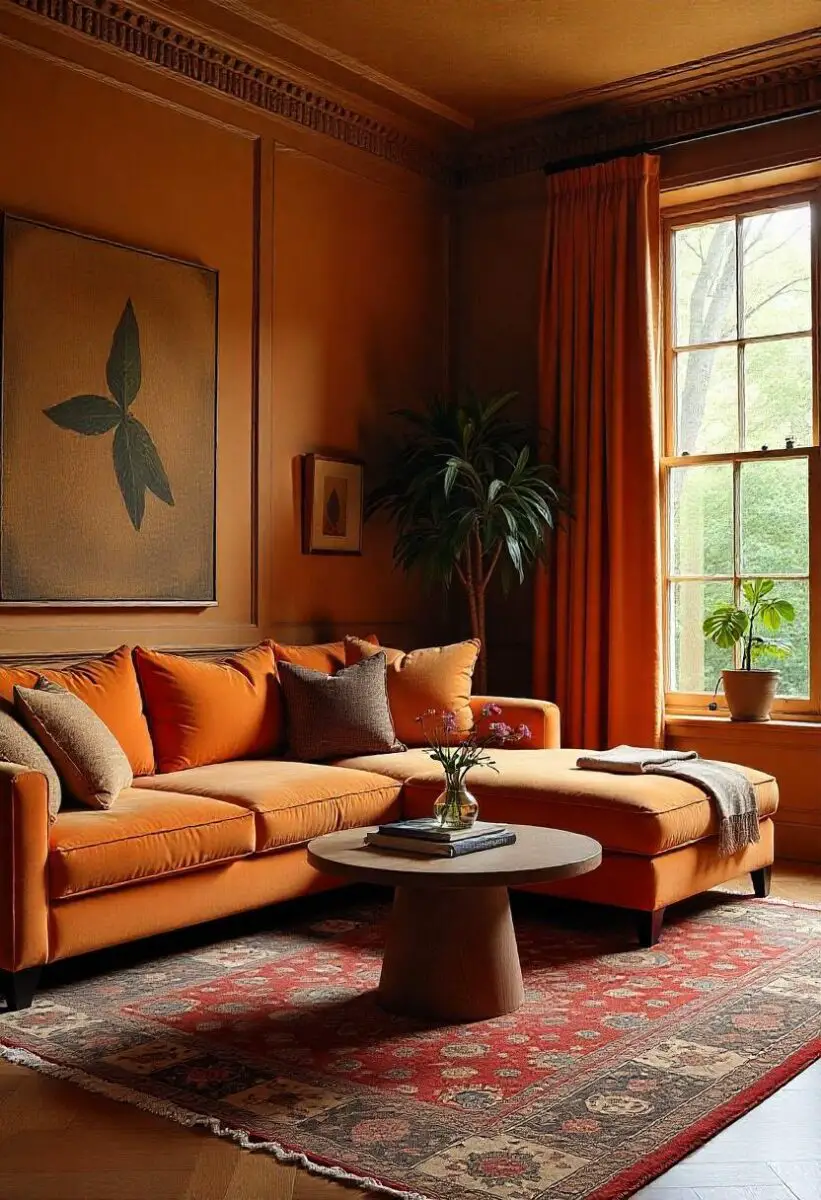
Consider upholstering a simple armchair in tweed, corduroy, or worn leather for an authentic professorial touch.
Choose textiles with subtle patterns – herringbone, houndstooth, or small plaids work beautifully within this aesthetic.
Add unexpected textural elements like a faux fur throw across an ottoman or sheepskin draped over a wooden chair.
Textiles should invite touch – your space should feel as intellectually stimulating as it is physically comfortable.
Consider the acoustics of your space as well – textiles help absorb sound, creating the hushed atmosphere of a well-appointed library.
✨Click to Get My 101 FREE Designer Room Ideas
9. Classical Music Corner: Creating an Auditory Aesthetic
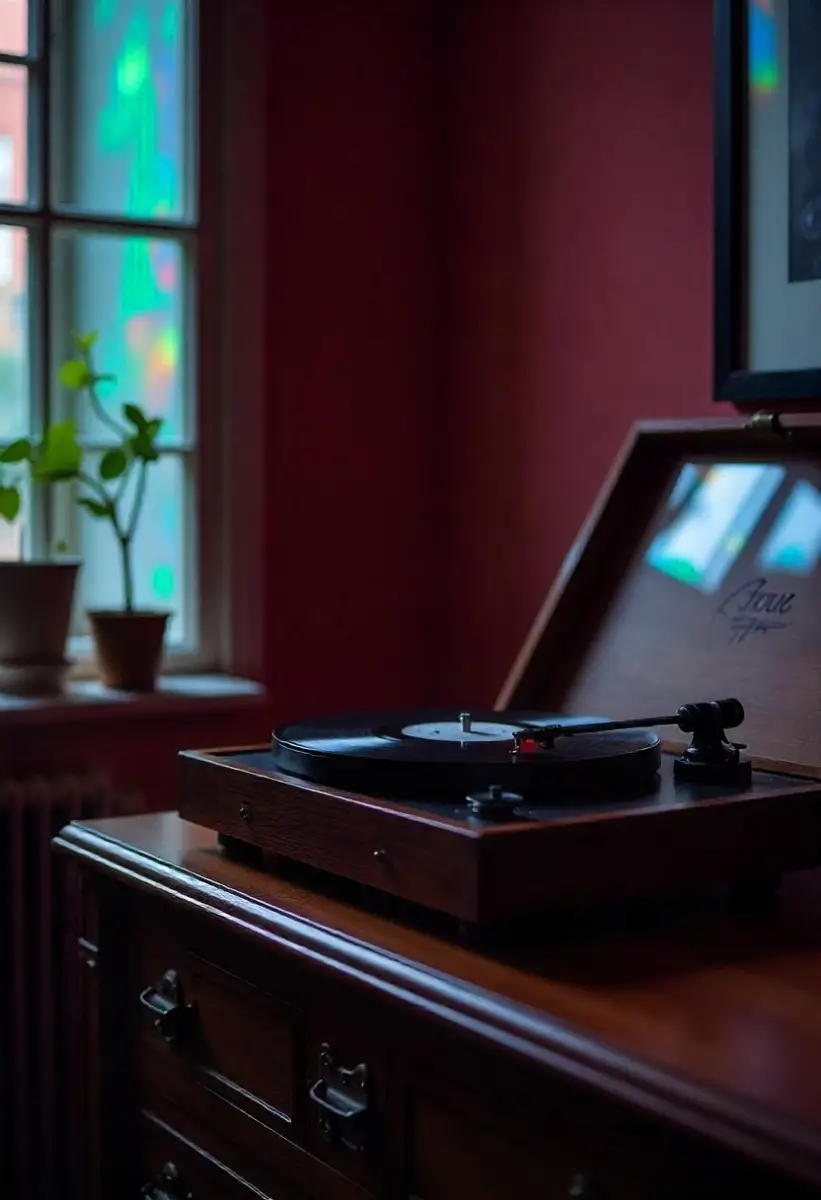
Establish a dedicated space for enjoying music that complements your intellectual pursuits and enhances your dark academia atmosphere.
Invest in a vintage record player or turntable with visible mechanical elements rather than hiding technology behind sleek modern designs.
Display vinyl records in wooden crates or on open shelving where their cover art becomes part of your visual aesthetic.
Collect classical recordings – Bach, Beethoven, Chopin, and Debussy provide perfect scoring for academic pursuits.
Consider a small collection of unusual instruments – a wooden flute, vintage violin, or antique music box add visual interest.
Frame sheet music or music theory diagrams as wall art to reinforce the auditory theme.
Position comfortable seating nearby to create a dedicated listening area for contemplative musical appreciation.
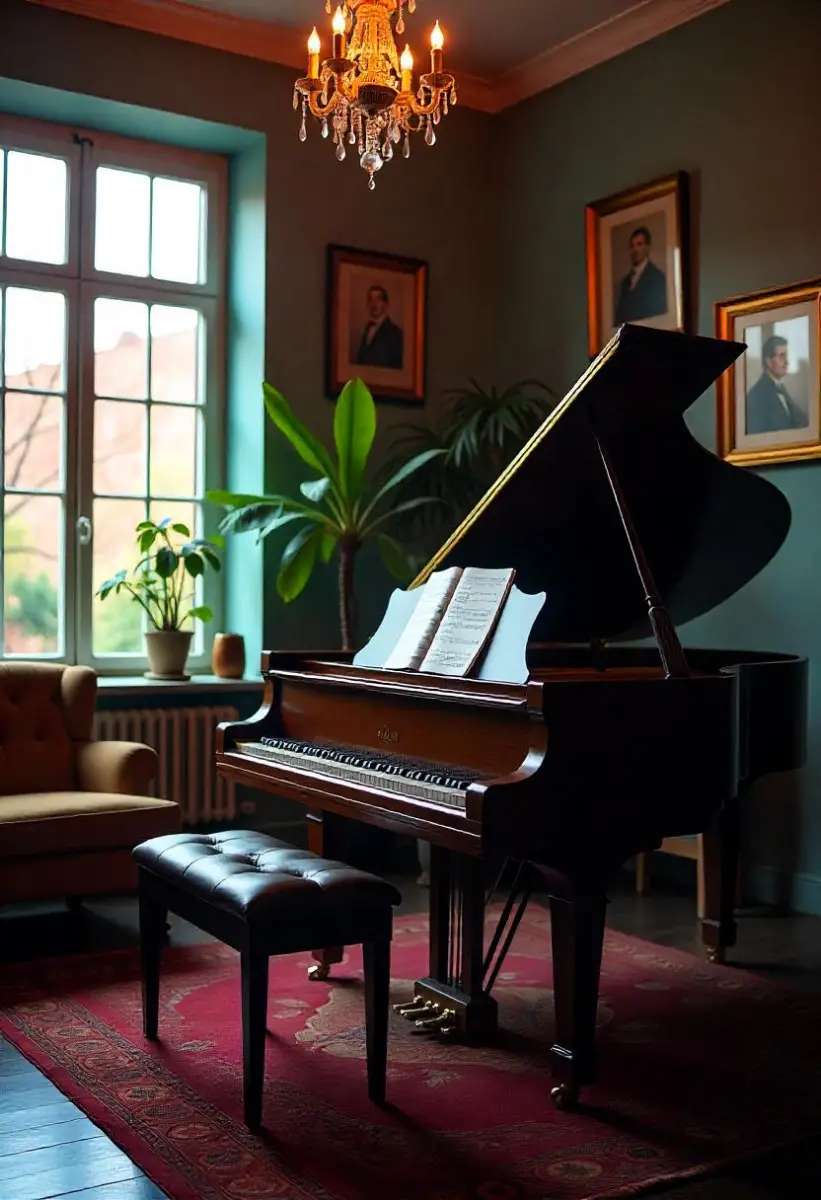
Add a small table for a brandy snifter or teacup to complete the sensory experience.
Display music-related books – biographies of composers, music theory texts, or historical accounts of musical movements.
Consider vintage speakers with exposed elements rather than modern minimalist options.
Your music corner should feel like a space where one might sit for hours contemplating the mathematical precision of Bach’s fugues.
For true authenticity, include a metronome, tuning fork, or other musician’s tools as decorative elements.
10. Tea and Libation Station: Fueling Intellectual Pursuits

Create a dedicated area for preparing and enjoying beverages that fuel late-night study sessions and philosophical discussions.
Seek out an antique bar cart, library trolley, or small side table to serve as your beverage station.
Collect vintage teapots, preferably silver, porcelain, or brown Betty-style ceramic with evidence of regular use.
Display teacups on saucers rather than mugs – bone china, mismatched vintage sets, or dark stoneware maintain the aesthetic.
Include a selection of loose-leaf teas stored in small tins or glass jars with handwritten labels.
Add appropriate tools – a tea strainer, sugar tongs, or a honey dipper made of silver or brass.
For evening libations, collect crystal decanters, vintage cocktail glasses, and a few select bottles of amber spirits.

Position your station near seating areas but not as a central focus – beverages support intellectual activity rather than becoming the main event.
Add a small stack of coasters made of marble, leather, or cork to protect your wooden surfaces.
Consider a vintage electric kettle covered with a tea cozy for practical brewing that doesn’t break the aesthetic.
Include a small framed quote about tea or spirits from a favorite author or historical figure.
Remember that this station should suggest hospitality and comfort without the commercial feel of a modern coffee bar.
11. Plant Life: Botanical Elements for the Academic Aesthetic

Incorporate plants that suggest botanical study rather than mere decoration – ferns, ivy, and specimens with interesting leaf structures.
Display your botanicals in terracotta pots, brass planters, or vintage ceramic containers rather than modern plastic pots.
Consider plants that thrive in lower light conditions, mirroring the scholarly preference for cozy, dim environments.
Create your own herbarium by pressing and framing interesting leaves, ferns, or flower specimens.
Position larger plants like rubber trees or fiddle leaf figs in corners to add height and living architecture to your space.
Incorporate dried elements – bundles of eucalyptus, lavender, or preserved fern fronds in dark glass bottles.
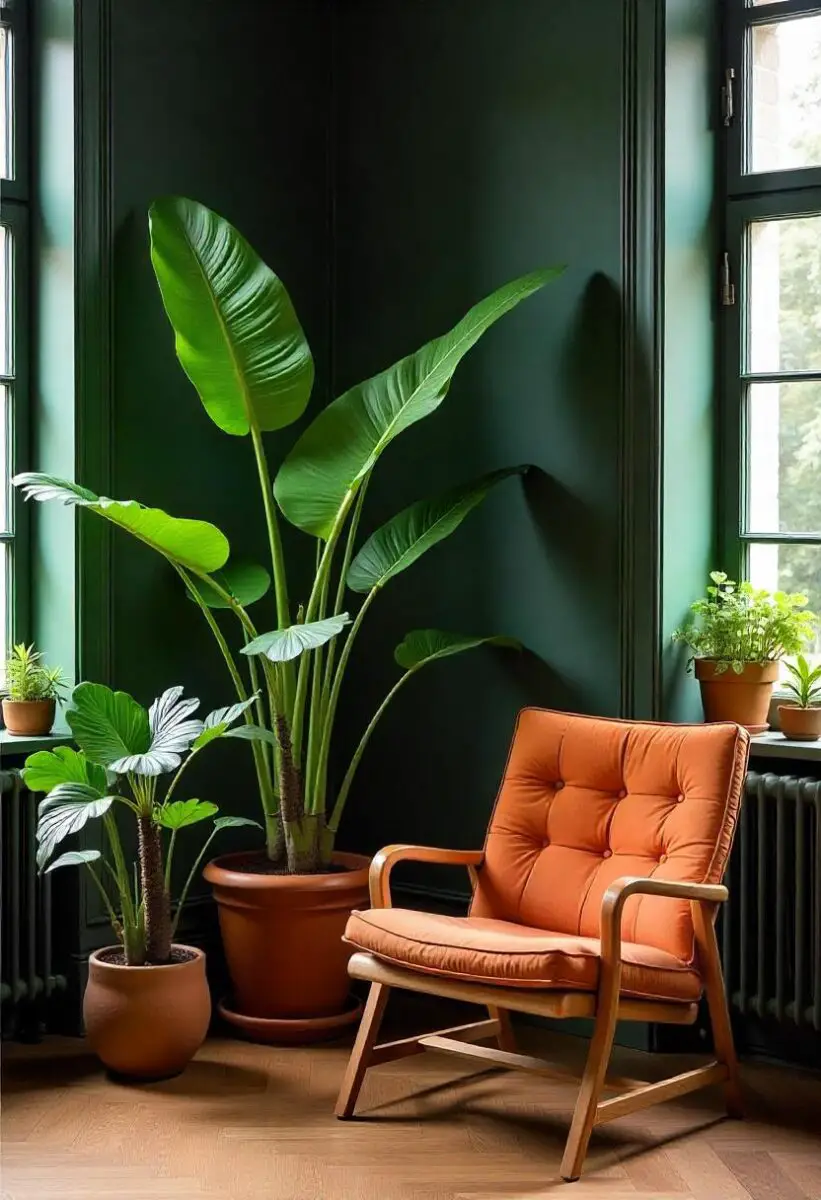
Collect unusual specimens like air plants displayed in glass terrariums or under bell jars for scientific appeal.
Add small potted herbs on windowsills – rosemary, sage, and thyme provide both visual interest and pleasant fragrance.
Consider a seasonal rotation of botanical elements – forcing bulbs in winter, displaying fresh flowers in spring, dried arrangements in autumn.
Position plants near your seating areas where their details can be admired during moments of contemplation.
Plants should appear to be objects of study as much as decorative elements – choose specimens with interesting botanical features.
Avoid overly colorful flowering plants in favor of those with architectural shapes and interesting textures.
12. Scent Profiles: Creating an Olfactory Experience

Develop a signature scent profile for your space that evokes libraries, old books, and scholarly pursuits.
Look for candles with notes of leather, tobacco, wood, vanilla, and amber to create a complex, layered fragrance.
Consider reed diffusers in amber bottles with subtle scents – avoid overly floral or sweet fragrances that don’t match the aesthetic.
Place small bowls of potpourri containing dried herbs, cinnamon sticks, and dried orange slices for natural fragrance.
Invest in quality incense – sandalwood, frankincense, or cedar – displayed in brass or stone holders.
Store fragrant items like coffee beans, tea leaves, or spices in glass containers where their scent can subtly permeate the space.
Place sachets of dried lavender or cedar chips in drawers and cabinets for a pleasant surprise when opened.
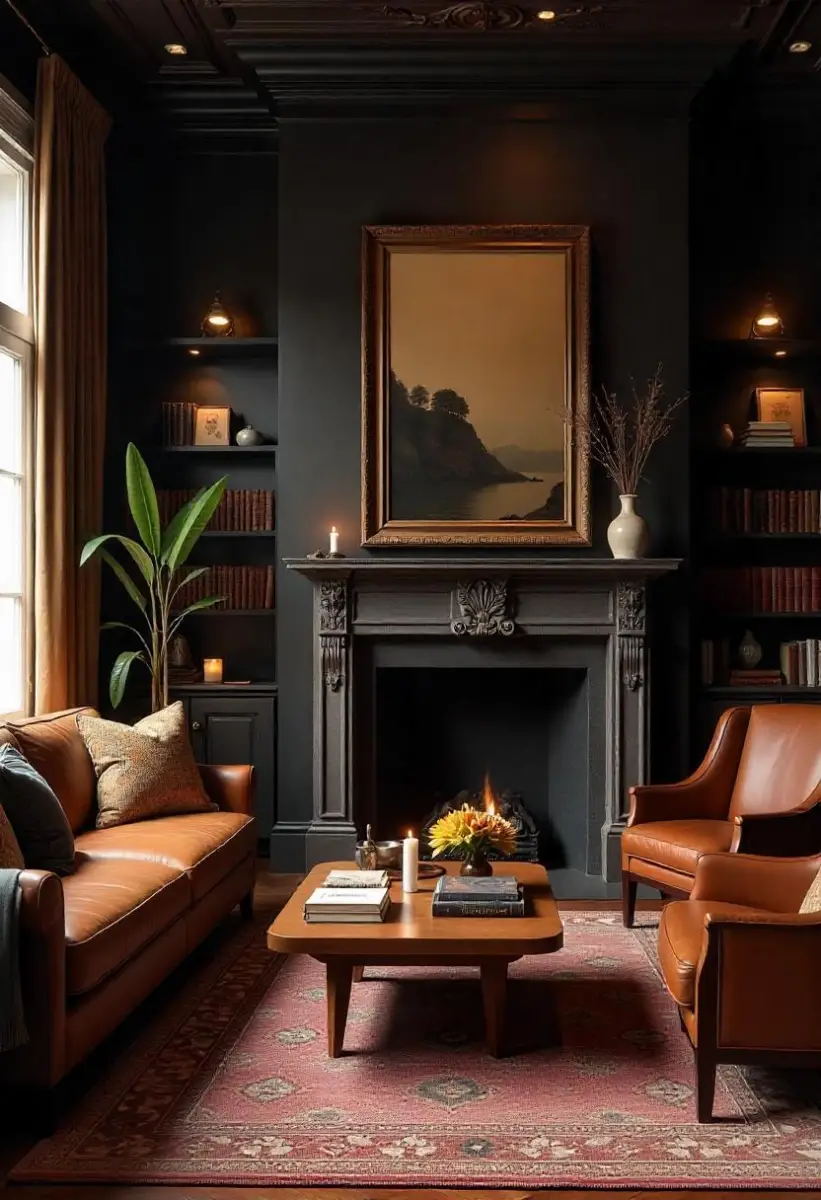
Consider a collection of essential oils in dark glass bottles with droppers for customizing your space’s scent profile.
Remember that scent is deeply tied to memory – choose fragrances that evoke scholarly environments or literary references.
Avoid artificial or overly manufactured scents in favor of natural elements whenever possible.
Create seasonal scent variations – cinnamon and clove in fall, pine and cedar in winter, subtle florals in spring.
The goal is to create an olfactory experience that complements the visual aesthetic without overwhelming the senses.
✨Click to Get My 101 FREE Designer Room Ideas
13. Analog Entertainment: Unplugged Scholarly Pursuits

Create spaces for screen-free entertainment that encourage conversation, contemplation, and intellectual growth.
Display board games with classic appeal – chess, backgammon, or Go sets with wooden pieces and boards.
Invest in a quality chess set with weighted pieces displayed on a side table, perpetually mid-game as if awaiting the next move.
Collect card games stored in wooden boxes or leather cases rather than cardboard packaging.
Consider puzzles with intellectual themes – world maps, famous artworks, or architectural landmarks.
Display these analog entertainment options on open shelving or in glass-fronted cabinets rather than hiding them away.

Create a dedicated game table with comfortable seating for long evenings of strategic thinking and friendly competition.
Add small notebooks for scoring games or recording particularly brilliant moves for future reference.
Position your analog entertainment near good lighting but away from main traffic areas to create a contemplative gaming environment.
Include reference materials related to your games – books on chess strategy or the history of particular games add scholarly context.
Games should appear to be tools for mental exercise rather than mere diversions.
Consider learning a new analog skill – calligraphy, bookbinding, or sketching – and display the tools prominently as evidence of ongoing intellectual development.

